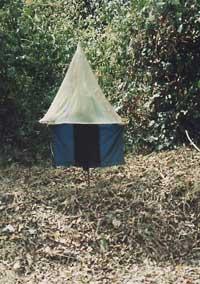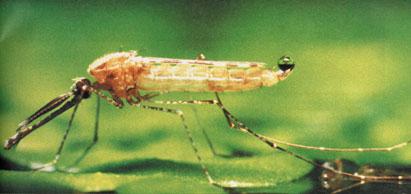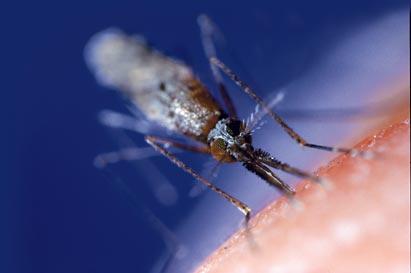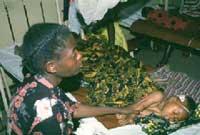Appreciated cows and genetically modified mosquitoes for prevention
2001/10/07 Mendiburu, Joana - Elhuyar Zientziaren Komunikazioa
In the countries of cold winters having to withstand disgusting flies is only a matter of summer. In Africa, on the contrary, flies are usually annoying throughout the year, but the truth is that by the bitor after the bite of the flies, at least, one could not speak of this topic. So let's go to the grain. The damage of the Tse-tse and Anopheles gambiae flies is not limited to the simple surface grain. The tse-tse fly transmits sleep disease and the second malaria. Therefore, it is necessary to analyze as soon as possible effective, cheap and viable solutions.

Sleep disease is suffered by humans and four-legged animals. As for animals, it is estimated that every year 46 million people from which 3 million die are contaminated. It is therefore responsible for the fact that cattle from the poor countries of Africa do not develop sufficiently. As for humans, the World Health Organization estimates that in 36 countries each year, 60 million people are at risk of contagion from sleep diseases.
In addition, every year between 20,000 and 50,000 new cases appear, of which 2-3% are killed. However, WHO considers that there are more cases of those who claim to be mortal if not treated. Africa has suffered three major epidemics of sleep disease in the last century, which began in 1970 and continues.
The damage of malaria is not at all minor. According to the World Health Organization, every year 400 million people suffer from malaria and, despite the cure of the disease, every year nearly two million people are killed. About 40% of the world's population is at risk of contagion and nine out of ten sick people reside in sub-Saharan Africa. The most frequent victims of malaria are children under the age of 5. Every day about 3,000 children die of malaria.
Artificial cows against the tse-tse fly
The most visible cows in Zimbabwe are not true, nor do they have cow shape or color. These artificial cows that can be found in all corners of the country, however, have to do with real cows, which have the same smell, which is the one that attracts the tse fly that contaminates the disease of sleep and nagan. But it is not enough to attract, we must also kill the fly, for which the cows are braided with insecticide.
The system is not new. It was developed in the 1980s by a team of researchers. Artificial cows attract flies thanks to a mixture of chemical substances. They are bitten directly with the conviction that they are in front of a beech and, just to realize, the wings are moistened with insecticide.

"Each trap costs $25, that is, about $27," says Stephen Fuentes, a professor at Greenwich University. Knowing that to achieve total efficiency four cows per square meter are needed, the expenditure per square meter is increased to 100 dollars. But that's just the placement phase. Then, as is obvious, you have to take care of the structures and distribute insecticides enough, and in that they also spend the same thing. Zimbabwe, this last phase is certified by the veterinary service. But according to the British doctor who works in artificial cows, in countries like Kenya the maintenance is done by its inhabitants, thus considerably reducing its expenses".
Despite relatively high expenditures, Zimbabwe opted for this technology about fifteen years ago. Currently, 60,000 artificial cows are distributed throughout the country, with encouraging results. In the last five years my lazy, animal sleep disease, has practically disappeared. In addition, Stephen Torre noted that similar results have also been obtained in Zambia, Ethiopia and Kenya. The good results are a big step forward for these African countries, which, although at first they represented great expenses, in the end they have won not only in health but also in money.
Therefore, even if cows are not decorative like those of Bilbao, in Africa they will probably also have a great future. However, everything is perfect and researchers warn that the tse-tse flies of the western countries of Africa are not crazy in trap. We must see if they are able to distinguish the smell or if the shape of the cow is related.
Genetically modified malaria mosquito

The mosquito carrying the parasite Plasmodium, which causes malaria, should be, in the near future, a very similar enemy. And it is because, because of so many deaths, scientists have sought a solution to end the mosquitoes definitively, and it seems that thanks to genetics they have walked the good way.
Ohio researcher Jacobs-Lorena detects a gene that prevents the parasite Plasmodium from reproducing and displacing. The gene blocks the receptor of the spinal gland and intestine. This receptor is the one used for the reproduction and transport of the parasite. The parasite Plasmodium loses its reproductive capacity by 85-90%, and thus, despite placing the parasite in a mosquito, half of the victims of the bite do not develop the disease.
However, all these investigations are very recent, and only genetically modified mosquitoes are used in the laboratory. In addition, skeptics warn that to fight malaria, many obstacles must be overcome. First of all, people must believe that the release of new mosquitoes will not cause harm and, on the other hand, we must determine the ecological consequences that cannot be produced by releasing new mosquitoes.
DDT has been more harmful than effective
DDT (dichlorodifeniltricloroethane) has for many years been a valued ally in the fight for diseases of transmission of pesticides by flies and mosquitoes, such as malaria and sleep disease.

DDT was first synthesized in 1874 and its properties were discovered in 1939 by Swiss chemist Paul Hermann Muller. The researchers soon realized that it was very effective against the lice of pesticides, fleas, mosquitoes and a series of insects that attacked crops, and at the same time most of the developed nations of the world began to produce large spectrum pesticides. The government of Zimbabwe, for example, before betting on cows in the 1980s, opened every year between 100 and 200 tons of DDT and used a total of 2,900 tons.
But in 1962 the biologist Rachel Carson published a book that would provoke a change of opinion on DDT. Unfortunately, the chemical compound was already included in the body of fish, cattle and in general all living beings. Currently, traces of DDT can also be found in the body of any person.
Subsequent studies have caused DDT to damage and hinder the growth of the immune system of the fetus or baby, which has caused the males of some species of fish to have become females, which alter the correct functioning of the hormones of all living beings, etc. Seen. As these damage has been investigated and carried out, the use of DDT has been banned in many countries.
Published in the supplement Natura de Gara.

Gai honi buruzko eduki gehiago
Elhuyarrek garatutako teknologia





